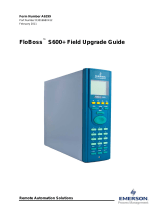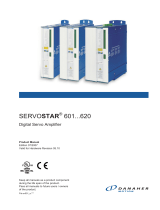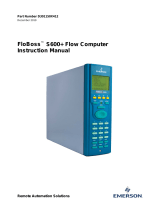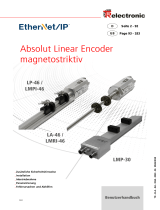
DeviceNet-Erweiterungskarte
DeviceNet Expansion Card
Carte d'Expansion DeviceNet
SERVOSTAR
®
S300 & S600 & S700
DEUTSCH Technische Beschreibung
ENGLISH Technical description
FRANÇAIS Description Technique
Ausgabe/Edition/Édition 04/2012
Datei/File/Fichier devicenet_def.***


Erweiterungskarte -DeviceNet-
Dieses Faltblatt beschreibt die DeviceNet Erweiterungskarte für S300/S600/S700.
Informationen zu Funktionsumfang und Softwareprotokoll finden Sie im Handbuch
"DeviceNet Kommunikationsprofil".
Einbau der Erweiterungskarte
Einbau der DeviceNet-Erweiterungskarte in den S300/S600/S700:
l
Hebeln Sie die Abdeckung des Optionsschachtes mit einem geeigneten
Schraubendreher heraus.
l
Achten Sie darauf, dass keine Kleinteile (Schrauben o.ä.) in den geöffneten
Optionsschacht fallen.
l
Schieben Sie die Erweiterungskarte vorsichtig und ohne sie zu verkanten in
die vorgesehenen Führungsschienen.
l
Drücken Sie die Erweiterungskarte fest in den Schacht, bis die Frontabde-
ckung auf den Befestigungslaschen aufliegt. So ist ein sicherer Kontakt der
Steckverbindung gewährleistet.
l
Drehen Sie die Schrauben der Frontabdeckung in die Gewinde in den Befesti-
gungslaschen.
Kombinierte Modul-/Netzwerkstatus-LED
LED ist Bedeutung:
aus
Das Gerät ist nicht online.
- Das Gerät hat den Dup_MAC_ID-Test noch nicht abgeschlossen.
- Das Gerät ist eventuell nicht eingeschaltet.
grün
Das Gerät läuft im normalen Zustand, ist online, und die Verbindungen sind im eta-
blierten Zustand.
- Das Gerät ist einem Master zugewiesen.
blinkt grün
Das Gerät läuft im normalen Zustand, ist online, und die Verbindungen sind nicht im
etablierten Zustand.
- Das Gerät hat den Dup_MAC_ID-Test bestanden und ist online, aber die
Verbindungen zu anderen Knoten sind nicht hergestellt.
- Dieses Gerät ist keinem Master zugewiesen.
- Fehlende, unvollständige oder falsche Konfiguration
blinkt rot
Behebbarer Fehler und/oder mindestens eine E/A-Verbindung befindet sich im
Wartestatus.
rot
- Am Gerät ist ein nicht behebbarer Fehler aufgetreten; es muss eventuell
ausgetauscht werden.
- Ausgefallenes Kommunikationsgerät. Das Gerät hat einen Fehler festgestellt,
der die Kommunikation mit dem Netzwerk verhindert (z. B. doppelte MAC ID
oder BUSOFF).
Frontansicht
Erweiterungskarten für S300/S600/S700 3
Kollmorgen 04/2012 Erweiterungskarte -DeviceNet-
DEUTSCH

Anschlusstechnik
Leitungsauswahl, Leitungsführung, Schirmung, Busanschlussstecker, Busabschluss und
Laufzeiten werden in der “DeviceNet Spezifikation, Band I, II", ODVA, beschrieben.
Anschlussbild
Beim SERVOSTAR 6xx müssen AGND und DGND (Stecker X3) gebrückt werden !
Einstellmöglichkeiten der Stationsadresse (Geräteadresse im DeviceNet-Bus)
l
Drehschalter an der Vorderseite der Erweiterungskarte auf einen Wert zwischen 0
und 63 stellen. Jeder Schalter stellt eine Dezimalziffer dar.
Um Adresse 10 für den Antrieb einzustellen, setzen Sie MSD auf 1 und LSD auf 0.
l
Drehschalter an der Vorderseite der Erweiterungskarte auf einen Wert über 63 stel-
len. Sie können die Stationsadresse jetzt anhand der ASCII-Befehle DNMACID x,
SAVE, COLDSTART einstellen, wobei "x" für die Stationsadresse steht.
l
Drehschalter an der Vorderseite der Optionskarte auf einen Wert über 63 stellen.
Jetzt die Stationsadresse über das DeviceNet-Objekt (Klasse 0x03, Attribut 1) ein-
stellen, normalerweise mit Hilfe eines DeviceNet-Inbetriebnahmewerkzeugs.
Alle Antriebsparameter werden im nichtflüchtigen Speicher gesichert, wenn der Wert
festgelegt wird. Den Antrieb nach der Änderung neu starten.
Einstellmöglichkeiten der Übertragungsgeschwindigkeit
l
Drehschalter für die Baudrate an der Vorderseite der Optionskarte auf einen Wert
zwischen 0 und 2 stellen, 0 = 125 KBit/s, 1 = 250 KBit/s, 2 = 500 KBit/s.
l
Drehschalter an der Vorderseite der Erweiterungskarte auf einen Wert über 2 stel-
len. Sie können die Baudrate jetzt anhand der Terminal-Befehle DNBAUD x, SAVE,
COLDSTART einstellen, wobei "x" für 125, 250 oder 500 steht.
l
Drehschalter an der Vorderseite der Erweiterungskarte auf einen Wert über 2 stel
-
len. Jetzt die Baudrate anhand des DeviceNet-Objekts (Klasse 0x03, Attribut 2) auf
einen Wert zwischen 0 und 2 einstellen, normalerweise mit Hilfe eines DeviceNet In
-
betriebnahmewerkzeugs. Alle Parameter werden im nichtflüchtigen Speicher gesi
-
chert, wenn der Wert festgelegt wird. Den Antrieb nach der Änderung neu starten.
4 Erweiterungskarten für S300/S600/S700
Erweiterungskarte -DeviceNet- 04/2012 Kollmorgen
DEUTSCH
S300/S600/S700

Buskabel
Gemäß ISO 898 sollten Sie ein Buskabel mit einer charakteristischen Impedanz von
120W verwenden. Die für eine zuverlässige Kommunikation nutzbare Kabellänge wird mit
ansteigender Übertragungsgeschwindigkeit reduziert. Die folgenden, von uns gemesse
-
nen Werte können als Richtwerte verwendet werden. Sie sollten jedoch nicht als Grenz
-
werte ausgelegt werden.
Allgemeines Merkmal Spezifikation
Bitraten 125 KBit, 250 KBit, 500 KBit
Abstand mit dicker
Sammelschiene
500 m bei 125 KBaud
250 m bei 250 KBaud
100 m bei 500 KBaud
Anzahl Knoten 64
Signalgebung CAN
Modulation Grundbandbreite
Medienkopplung Gleichstromgekoppelter Differentialsende-/Empfangsbetrieb
Isolierung 500 V (Option: Optokoppler auf Knotenseite des Transceivers)
Typische Differenzialein-
gangsimpedanz (rezessiver
Status)
ShuntC=5pF
ShuntR=25KW (power on)
Min. Differenzialeingangs-
imp. (rezessiver Status)
Shunt C = 24pF + 36 pF/m der dauerhaft befestigten Abzweigleitung
ShuntR=20KW
Absoluter, maximaler
Spannungsbereich
-25 V bis +18 V (CAN_H, CAN_L). Die Spannungen an CAN_H und
CAN_L sind auf den IC-Massepin des Transceivers bezogen. Diese
Spannung ist um den Betrag höher als die V-Klemme, der dem Span-
nungsabfall an der Schottky-Diode entspricht (max. 0,6V).
Erdung:
Um Erdungsschleifen zu verhindern, darf das DeviceNet-Netzwerk nur an einer Stelle
geerdet sein. Die Schaltkreise der physischen Schicht in allen Geräten sind auf das
V-Bussignal bezogen. Der Anschluss zur Masse erfolgt über die Busstromversorgung.
Der Stromfluss zwischen V- und Erde darf über kein anderes Gerät als über eine Strom-
versorgung erfolgen.
Bustopologie:
Das DeviceNet-Medium verfügt über eine lineare Bustopologie. Auf jeder Seite der Ver-
bindungsleitung sind Abschlusswiderstände erforderlich. Abzweigleitungen bis zu je 6 m
sind zulässig, so dass mindestens ein Knoten verbunden werden kann.
Abschlusswiderstände:
Für DeviceNet muss an jeder Seite der Verbindungsleitung ein Abschlusswiderstand
installiert werden. Widerstandsdaten: 120W, 1% Metallfilm, 1/4 W
Erweiterungskarten für S300/S600/S700 5
Kollmorgen 04/2012 Erweiterungskarte -DeviceNet-
DEUTSCH

Expansion card -DeviceNet-
This flyer describes the DeviceNet expansion card for S300/S600/S700.
Information on the range of functions and the software protocol can be found in the
manual "DeviceNet communication profile".
Fitting the expansion card
To fit the DeviceNet expansion card into a S300/S600/S700, proceed as follows:
l
Use a suitable screwdriver to lever off the cover of the option slot.
l
Take care that no small items (such as screws) fall into the open option slot.
l
Push the expansion card carefully into the guide rails that are provided, wit-
hout twisting it.
l
Press the expansion card firmly into the slot, until the front cover touches the
fixing lugs. This ensures that the connectors make good contact.
l
Screw the screws on the front cover into the threads in the fixing lugs.
Combined Module/Network Status LED
LED is To indicate:
off
Device is not online.
- The device has not completed the Dup_MAC_ID test yet.
- The device may not be powered.
green
The device is operating in a normal condition and the device is online with connections
in the established state.
- The device is allocated to a Master
flashing
green
The device is operating in a normal condition and the device is online with no connec-
tions in the established state.
- The device has passed the Dup_MAC_ID test, is online, but has no established
connections to other nodes.
- This device is not allocated to a master.
- Configuration missing, incomplete or incorrect.
flashing
red
Recoverable fault and/or one or more I/O Connections are in the Timed–Out state.
red
- The device has an unrecoverable fault; may need replacing.
- Failed communication device. The device has detected an Error that has rendered
it incapable of communicating on the network (e.g. Duplicate MAC ID, or Bus–off).
Front view
Connection technology
Cable selection, cable routing, shielding, bus connector, bus termination and transmis
-
sion times are all described in the “DeviceNet specification, volumes I, II", published by
ODVA
6 Expansion Card for S300/S600/S700
Expansion card -DeviceNet- 04/2012 Kollmorgen
ENGLISH

Connection diagram
With SERVOSTAR 6xx terminals AGND and DGND (connector X3) must be joined
together !
Setting the station address
Three different ways to set the station address (device address on the DeviceNet-Bus) for
the servo amplifier:
l
Set the rotary switches on the front panel of the option card to a value between 0
and 63. Each switch represents one decimal digit. To set the drive to address 10, set
the MSD (most significant digit) switch to 1 and the LSD (least significant digit)
switch to 0.
l
Set the rotary switches on the front panel of the expansion card to a value greater
than 63. The station address can now be set using the ASCII commands DNMACID
x, SAVE, COLDSTART where x is the station address.
l
Set the rotary switches on the front panel of the expansion card to a value greater
than 63. The station address can now be set through the DeviceNet object (class
0x03, attribute 1). This is typically done through a DeviceNet commissioning tool. All
drive parameters will be saved to the non-volatile memory when the value is set. The
drive must be restarted after modifying the address.
Setting the transmission rate
Three different ways to set the DeviceNet transmission rate:
l
Set the rotary baudrate switch on the front panel of the option card to a value bet-
ween 0 and 2. 0=125kbit/s, 1=250kbit/s, 2=500kbit/s.
l
Set the baudrate switch on the front panel of the expansion card to a value greater
than 2. The baud rate can now be set using the terminal commands DNBAUD x,
SAVE, COLDSTART where x is 125, 250 or 500.
l
Set the baudrate switch on the front panel of the expansion card to a value greater
than 2. The baud rate can now be set through the DeviceNet object (class 0x03, at
-
tribute 2) to a value between 0 and 2. This is typically done through a DeviceNet
commissioning tool. All drive parameters will be saved to the non-volatile memory
when the value is set. The drive must be restarted after modifying the baud rate.
Expansion Card for S300/S600/S700 7
Kollmorgen 04/2012 Expansion card -DeviceNet-
ENGLISH
S300/S600/S700

Bus cable
To meet ISO 898, a bus cable with a characteristic impedance of 120 W should be used.
The maximum usable cable length for reliable communication decreases with increasing
transmission speed. As a guide, you can use the following values which we have measu
-
red, but they are not to be taken as assured limits.
General characteristic Specification
Bit rates 125 kbit, 250 kbit, 500 kbit
Distance with larger
bus connections
500 meters at 125 kBaud
250 meters at 250 kBaud
100 meters at 500 kBaud
Number of nodes 64
Signal environment CAN
Modulation Basic bandwidth
Coupling medium DC-coupled differential transmit/receive operation
Isolation 500 V (option: optocoupler on the transceiver's node side)
Typical differential input impe-
dance (recessive state)
ShuntC=5pF
ShuntR=25KW (power on)
Min. differential input impe-
dance (recessive state)
Shunt C = 24pF + 36 pF/m of the permanently
attached stub cable
ShuntR=20KW
Absolute max.
voltage range
-25 V to +18 V (CAN_H, CAN_L)
The voltages for CAN_H and CAN_L refer to the ground pin of the
transceiver. The voltage is higher than that on the V-terminal by
the amount of the forward voltage drop of the Schottky diode. This
voltage drop must be < 0.6V.
Grounding:
The DeviceNet network must only be grounded at one point, to avoid ground loops. The
circuitry for the physical layer in all devices are referenced to the V-bus signal. The
ground connection is made via the power supply for the bus system. The current flowing
between V- and ground must not flow through any device other than the power supply.
Bus topology:
The DeviceNet medium utilizes a linear bus topology. Termination resistors are required
at each end of the connecting cable. Stub cables are permitted up to a length of 6 meters,
so that at least one node can be connected.
Termination resistors:
DeviceNet requires a termination at each end of the connecting cable.
These resistors must meet the following requirements: 120W, 1% metal-film, 1/4 W
8 Expansion Card for S300/S600/S700
Expansion card -DeviceNet- 04/2012 Kollmorgen
ENGLISH

Carte d'expansion -DeviceNet-
Ce documentation décrit la carte d’expansion DeviceNet de l’automate S300/S600/S700.
Les informations relatives à l’étendue des fonctions et le protocole logiciel figurent dans
le manuel relatif au profil de communication DeviceNet.
Montage de la carte d'expansion
Pour adapter la carte d’expansion PROFIBUS dans S300/S600/S700, opérez comme suit
l
Soulever le couvercle de l’emplacement des options à l’aide d’un tournevis ap
proprié.
l
S’assurer qu’aucune petite pièce (vis ou autres) ne chute dans l’emplacement
ouvert.
l
Engager la carte d’expansion dans la fente et, sans la basculer, entre les rails
de guidage prévus à cet effet.
l
Enfoncer la carte d’expansion à fond dans la fente jusqu’à ce que le recouvre-
ment frontal vienne au contact de la patte de fixation. Le contact sûr de la
connexion est alors assuré.
l
Visser les vis du recouvrement frontal dans les alésages filetés de la patte de
fixation.
Combinaison LED de module/état du network
LED Signification :
éteinte
L’appareil n’est pas en ligne.
- L’appareil n’a pas encore terminé le test Dup_MAC_ID.
- L’appareil n’est peut-être pas branché.
verte
L’appareil fonctionne normalement, est en ligne et les connexions sont établies.
- L’appareil est subordonné à un maître.
verte
cligno-
tante
L’appareil fonctionne normalement, est en ligne et les connexions ne sont pas établies.
- L’appareil a réussi le test Dup_MAC_ID et est en ligne, mais les connexions aux
autres noeuds ne sont pas établies.
- Cet appareil n’est pas subordonné à un maître.
- Configuration absente, incomplète ou incorrecte.
rouge
cligno-
tante
Erreur réparable et/ou au moins une connexion E/S est en veille.
rouge
- Une erreur impossible à corriger est survenue sur l’appareil ; il devra peut-être être
remplacé.
- Appareil de communication défaillant. L’appareil a constaté une erreur qui empêche
la communication avec le réseau (p. ex. double ID MAC ou BUSOFF).
Vue de face
Carte d'expansion pour S300/S600/S700 9
Kollmorgen 04/2012 Carte d'expansion -DeviceNet-
FRANÇAIS

Technique de raccordement
Le choix des câbles, le câblage, le blindage, le connecteur, la terminaison de bus et les
temps de fonctionnement sont décrits dans le document “Spécification DeviceNet, tome I,
II", publié par l’ODVA.
Schéma de raccordement
Avec SERVOSTAR 6xx AGND et DGND (connecteur X3) doivent être strappés !
Possibilités de réglage de l’adresse de station (adresse de l’appareil)
l
Régler le commutateur rotatif situé sur la face avant de la carte d’expansion sur une
valeur comprise entre 0 et 63. Chaque commutateur représente un chiffre décimal.
Pour ajuster l’adresse 10 du variateur, définissez MSD sur 1 et LSD sur 0.
l
Régler le commutateur rotatif situé sur la face avant de la carte d’expansion sur une
valeur supérieure à 63. Vous pouvez maintenant ajuster l’adresse de la station à
l’aide des commandes ASCII DNMACID x, SAVE, COLDSTART,«x»correspon-
dant à l’adresse de la station.
l
Régler le commutateur rotatif situé sur la face avant de la carte d’expansion sur une
valeur supérieure à 63. Régler maintenant l’adresse sur l’objet DeviceNet (classe
0x03, attribut 1), normalement au moyen d’un outil de mise en service DeviceNet. Si
la valeur est définie, tous les paramètres du moteur sont conservés dans la mémoire
non volatile. Redémarrer le variateur une fois la modification effectuée.
Possibilités de réglage de la vitesse de transmission
l
Régler le commutateur rotatif de la vitesse de transmission, situé sur la face avant
de la carte d’option, sur une valeur comprise entre 0 et2;0=125Kbit/s,
1 = 250 Kbit/s, 2 = 500 Kbit/s.
l
Régler le commutateur rotatif situé sur la face avant de la carte d’option sur une va-
leur supérieure à 2. Vous pouvez maintenant ajuster la vitesse de transmission à
l’aide des commandes du terminal DNBAUD x, SAVE, COLDSTART,«x»corre-
spondant à 125, 250 ou 500.
l
Régler le commutateur rotatif situé sur la face avant de la carte d’option sur une va-
leur supérieure à 2. Régler maintenant la vitesse de transmission à l’aide de l’objet
DeviceNet (classe 0x03, attribut 2) sur une valeur comprise entre 0 et 2, normale
-
ment au moyen d’un outil de mise en service DeviceNet. Si la valeur est définie, tous
les paramètres sont conservés dans la mémoire non volatile. Redémarrer le moteur
une fois la modification effectuée.
10 Carte d'expansion pour S300/S600/S700
Carte d'expansion -DeviceNet- 04/2012 Kollmorgen
FRANÇAIS
S300/S600/S700

Câble de bus
Conformément à la norme ISO 898, vous devriez utiliser un câble de bus avec une impé
-
dance caractéristique de 120W. L’augmentation de la vitesse de transmission permet de
réduire la longueur de câble à utiliser pour une communication fiable. Les valeurs suivan
-
tes que nous avons mesurées peuvent servir de valeurs de référence. Elles ne devraient
cependant pas être interprétées comme des valeurs limites.
Caractéristique générale Spécification
Débit 125 Kbit, 250 Kbit, 500 Kbit
Distance avec le rail
collecteur
épais
500 m pour 125 KBaud
250 m pour 250 KBaud
100 m pour 500 KBaud
Nombre de noeuds 64
Signalisation CAN
Modulation Bande passante de base
Couplage multimédia Mode de réception/terme différentiel couplé en continu
Isolation 500 V (Option : optocoupleur, côté noeud de transceiver)
Impédance d’entrée diffé-
rentielle type (état récessif)
ShuntC=5pF
ShuntR=25KW (sous tension)
Impédance d’entrée diffé-
rentielle min. (état récessif)
Shunt C = 24pF + 36 pF/m de la dérivation stable fixée
ShuntR=20KW
Gamme de tensions
maximale
absolue
-25 V à +18 V (CAN_H, CAN_L). Les tensions de CAN_H et CAN_L
appliques à la broche de masse CI de transceiver. La valeur de cette
tension est plus élevée que celle de la borne V, qui correspond à la
baisse de tension de la diode à barrière de Schottky (max. 0,6 V).
Mise à la terre :
pour éviter des boucles de terre, le réseau DeviceNet ne doit être mis à la terre qu’en un
seul point. Les circuits de commutation de la couche physique de tous les appareils sont
rapportés au signal de bus V. Le raccordement à la masse s’effectue via l’alimentation en
courant du bus. La conduction électrique entre la borne V et la terre ne peut s’effectuer
par l’intermédiaire d’aucun autre appareil qu’une alimentation en courant.
Topologie du bus :
le support DeviceNet dispose d’une topologie de bus linéaire. Des résistances de ter-
minaison sont requises de chaque côté du câble de raccordement. Des dérivations allant
jusqu’à 6 m sont autorisées de manière à permettre le raccordement d’au moins un
noeud.
Résistances de terminaison :
pour DeviceNet, il faut installer une résistance de terminaison de chaque côté du
câble de raccordement. Données de résistance : 120W, 1 % film métallique, 1/4 W
Carte d'expansion pour S300/S600/S700 11
Kollmorgen 04/2012 Carte d'expansion -DeviceNet-
FRANÇAIS

Technische Änderungen, die der Verbesserung der Geräte dienen,
vorbehalten!
Alle Rechte vorbehalten. Kein Teil des Werkes darf in irgendeiner Form (Druck,
Fotokopie, Mikrofilm oder in einem anderen Verfahren) ohne schriftliche Genehmi
-
gung der Firma Kollmorgen Europe GmbH reproduziert oder unter Verwendung
elektronischer Systeme verarbeitet, vervielfältigt oder verbreitet werden.
Technical changes which improve the performance of the equipment may be
made without prior notice!
All rights reserved. No part of this work may be reproduced in any form (by prin-
ting, photocopying, microfilm or any other method) or stored, processed, copied or
distributed by electronic means, without the written permission of Kollmorgen
Europe GmbH .
Sous réserve de modifications techniques apportés en vue d'amélioration
des appareils !
Tous droits réservés. Sans autorisation écrite de l'entreprise Kollmorgen Europe
GmbH , aucune partie de cet ouvrage n'a le droit d'être ni reproduite par des moy-
ens quelconques (impression, photocopie, microfilm ou autre procédure) ni traitée,
polycopiée ou distribuée au moyen de systèmes électroniques.
Kollmorgen Customer Support North America
Internet
www.kollmorgen.com
E-Mail [email protected]
Tel.: +1 - 540 - 633 - 3545
Fax: +1 - 540 - 639 - 4162
Kollmorgen Customer Support Europe
Internet
www.kollmorgen.com
E-Mail [email protected]
Tel.: +49(0)2102 - 9394 - 0
Fax: +49(0)2102 - 9394 - 3155
-
 1
1
-
 2
2
-
 3
3
-
 4
4
-
 5
5
-
 6
6
-
 7
7
-
 8
8
-
 9
9
-
 10
10
-
 11
11
-
 12
12
Kollmorgen SERVOSTAR S300 Technical Description
- Type
- Technical Description
- This manual is also suitable for
Ask a question and I''ll find the answer in the document
Finding information in a document is now easier with AI
in other languages
- français: Kollmorgen SERVOSTAR S300
- Deutsch: Kollmorgen SERVOSTAR S300
Related papers
-
Kollmorgen SERVOSTAR 400 Assembly & Installation
-
Kollmorgen S700 Series Original Manual
-
Kollmorgen SERVOSTAR 400 Quick start guide
-
Kollmorgen S72401 User manual
-
Kollmorgen SERVOSTAR 500 Safety Manual
-
Kollmorgen SERVOSTAR 300 User manual
-
Kollmorgen S7030 User manual
-
Kollmorgen AKMH6 User manual
-
Kollmorgen s748 Safety Manual
-
Kollmorgen S700 Series Translation Of The Original Manual
Other documents
-
TCL S600 User manual
-
 Remote Automation Solutions S600+ Field User guide
Remote Automation Solutions S600+ Field User guide
-
Schneider Electric ATV312 DeviceNet Owner's manual
-
Beyerdynamic Classis GM 315 SP User manual
-
 STRIPE S700 Android-Based Smart Device User manual
STRIPE S700 Android-Based Smart Device User manual
-
 SSI America 601...620 User manual
SSI America 601...620 User manual
-
 Remote Automation Solutions S600+ Owner's manual
Remote Automation Solutions S600+ Owner's manual
-
AVENTICS Coupleur de bus AES/pilote de vanne AV DeviceNet User manual
-
 TR-Electronic LMPI-46 Installation guide
TR-Electronic LMPI-46 Installation guide
-
AVENTICS Bus Control CMS, B-Design, DeviceNet Owner's manual
















